Unreal II: The Awakening
Review - Rob and Tom tackle the FPS game which really is due out on Friday
Good afternoon, and welcome to Unreal II. Skaarj fan? You've come to the right place. Nali sympathiser? You'll enjoy this. But before we head inside, let me ask you a question: just what do you want from Unreal II? Because if you know what you want, I can give you a buying decision right now. It's very simple. Are you an FPS fan who just wants another enjoyable, well-rounded Shooter in the sci-fi vein? Great stuff. Turn yourself around, and enjoy our complimentary plane-ride home. You can buy the game tomorrow. By the way, your in-flight entertainment is a choice of Return to Castle Wolfenstein, Soldier Of Fortune II: Double Helix and Jedi Knight II…
I see that many of you connoisseurs are still with us. Indeed, those of you with slightly higher expectations should continue on to the auditorium, where we will make our address. And make yourselves comfortable - we get the feeling Colin Powell's job was probably easier than this one.

Space Oddity
Unreal II begins with deceptive simplicity - as Marshal John Dalton arrives on Odyssey IV for his latest briefing. The planet is a lush, green world and the Terran Colonial Authority (TCA) outpost is suspended several hundred metres above a sunny peninsula. It's here that Dalton learns that his new pilot is a Hex-Core alien called Ne'Ban, that he will not be reinstated to the Marine Corps, and that he can either get on with his patrols or head downstairs for some training, or take the unspoken third option of throwing himself into the sea.
Faced with this, we left the command tower - a basic structure rimmed with console banks and serviced by an odd-looking alien, the likes of which we've seen in Shooters as old as Deus Ex and Quake II - for all the world grief-stricken at the banality of the whole thing. Where is the gripping, pivotal event which should shake John's life and inject some intrigue? Where is the Unreal we've been missing? However it was then that we went outside and lent over the balcony, and the view hit us. Bloody hell this Unreal II technology is good looking.
It's a theme that runs throughout Unreal II, which gradually picks up in a predictable manner. Once you've wiped from your face the admiration at the sheer draw distance, the waves lapping up the shore and the incredibly detailed character models of the two marines guarding the elevator in the foreground of this serene vista, you get on with things much as you'd expect.
Heading downstairs to the training room, you're treated to basic jump/crouch initiation and a training course - during which you're taught that you can clamber up tall crates (unassailable in the eyes of modern FPS convention) by holding space instead of tapping it, that your HUD and health system are Halo-esque with a weak shield bar protecting your actual health, that you can absorb shield energy from dispatched enemies, and how some of the game's weapons function. After this, you're given a very brief and very easy deathmatch runabout by your instructor, whose repertoire includes "we've been waiting ages for this tech upgrade" and an in-joke about CTF.
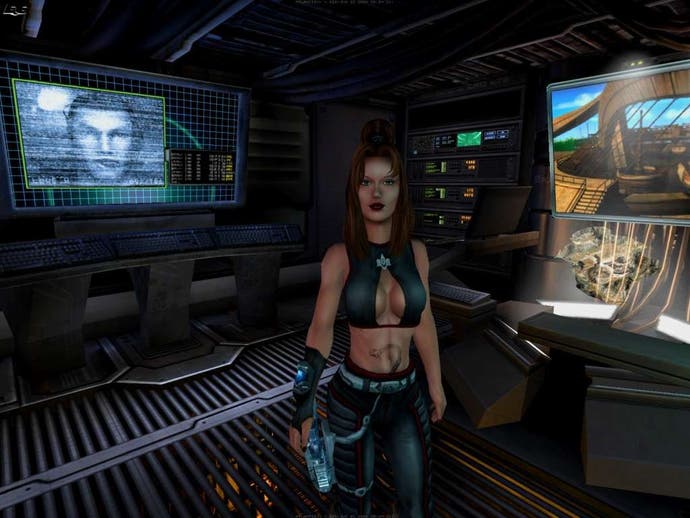
Feeling Good
From here you head back to your ship, the Atlantis, which will serve as the hub of your various activities over the course of The Awakening, tooling you up with weapons and fleshing out the details. It's here you meet your pointlessly well-endowed but gravely spoken female first officer Aida, disgraced, chain-smoking technician Izaak and your Hex-Core pilot Ne'Ban, whose deliberately broken English is a source of light humour between briefings. Ne'Ban is a useful tool for the developer, because in explaining the current galactic situation to him, John can also introduce us to the concepts at work.
The Atlantis is another demonstration of the beauty of Unreal II. It is effectively a couple of stacked round hallways with sleeping quarters, a storage/armoury room, a briefing room, Ne'Ban's bridge and your little shuttle's hangar, and a ladder connecting the two levels, but through the magnificence of the game engine it's transformed into a Giger-esque monstrosity - reflections beam from every console and sheet of metal, gangways of gratings clink beneath your feet and pipes, exposed system boards and technology flashes at you from all directions, as the shadows plunge much of your surroundings into hazy darkness - even the fairly hammered locker doors glint realistically.
Incidental detail fills the gaps with everything from a multi-tiered alien chess set, a holographic projector in the briefing room and Windows-style operating systems on each computer console to the wobble of Aida's rear-end and the various prosthetic gizmos sticking out of Izaak - not to mention the wispy smoke billowing from his cigarette. On a related note, smoke in Unreal II can be affected by explosions, fans and just about anything else - a totally unnecessary but helpfully immersive little touch.
Given the clearly jaw-dropping graphics engine, a selection of well lip-synched and potentially deep (albeit clichéd) characters and a tale of forgotten glory lapsed into marshaldom, we were left expecting great things. This low-key opening had enough surprises and unanswered questions to leave us excited - and if the game could blossom into a Shooter worthy of the name Unreal, encompassing all the atmosphere, intelligent, varied design and cinematic cunning that the name demands, then we knew we'd be singing the game's praises for years to come.
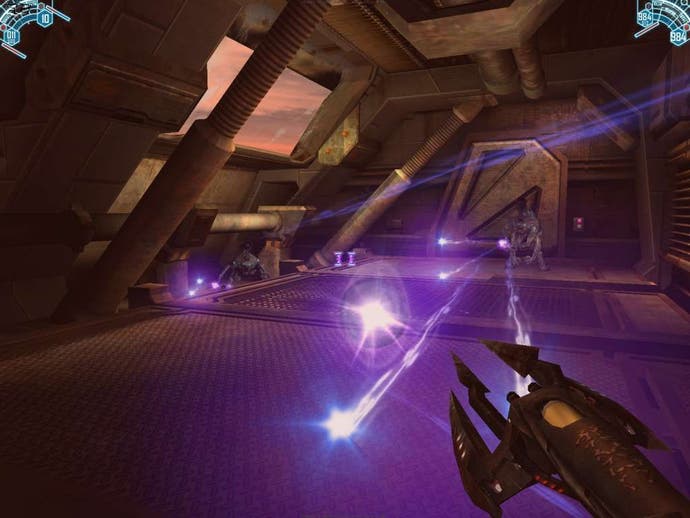
Breaking Point
At the end of the first of the game's twelve main missions though, we knew that we wouldn't. Sanctuary, the fifth planet in the Elara system plays host to a Liandri mining facility, the briefing told us. And of course all we've heard from them is a distress signal. "Aliens, anyone?" we muttered, only to have our suspicions confirmed.
To begin with, there's an Alien/Unreal-esque reluctance to show us an enemy. As with the original, you catch fleeting glimpses of an unknown threat, which seems to move quickly and kill rather messily - the bodies, impaled heads and limbs strewn about the place speak volumes. Miners screaming for help are dragged Half-Life-style beneath closing doors as blood splatters the floor, and on the whole the suspense is successfully built - not least thanks to the music. You clutch your machine gun tightly and wander deeper as Aida voices her "bad feeling" concerns over the radio. Then you encounter the enemy and it's… a blue monkey with a stick. A few machine gun rounds later and you wonder what all the fuss was about.
Later in the same level, the developer recycles the same suspense-building trick, only this time in a darkened elevator with a fiend-like Skaarj enemy, which moves quickly and absorbs more ammo. The rest of the level has you fighting swathes of blue monkeys and the occasional Skaarj as you try to reach one last, surviving miner in the depths of the facility. The level culminates in a jumping puzzle and a boss encounter, with a slow-moving monster whose quickfire blobs will kill you almost instantly unless you keep backing away out of sight between shots.
Is that it?
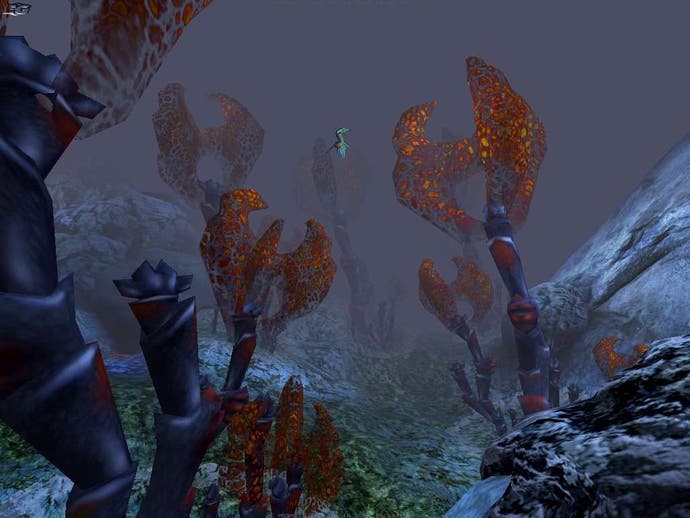
Yes
It really is! Of course you can't fault the composition. The worlds of Unreal II are exquisitely detailed and beautiful, from the metallic, sci-fi templated installation-style of the Sanctuary and the immense weapons research facility on the snowy desert rock called Hell, to the lightning-lit, soggy, marshy swamp soiree as you wait to be rescued from waves of onrushing aliens, and the throbbing might of a planet-wrapping monster, with a Sarlaac-esque opening to the misty depths of its Xen-inspired interior.
Everything is drenched in detail and every sci-fi cliché from as far back as we can remember is in there. Electronic forcefield type shield walls, which can be used to block entrances? Check. Automatic sentry guns, which are used both for and against the player? Check. Ventilation systems packed with legions of pesky little "make you jump" critters? Check. Fiery obstacles, which have to be rerouted via switch hunting antics? Check. Rooms full of laser beams, which have to be navigated in order to reach the "off" button? Check. Being held captive in a corridor with guns trained on you while a companion "hacks the security"? Check.
There's almost no limit to the amount of sci-fi type scenarios Legend can pack into a level - it's just there's virtually no sense of imagination whatsoever! The best moments are all down to the technology - a huge sleeping alien to be tiptoed past on a bridge, which will stomp after you (particularly since you dispatched its baby) if you wake it up; the body of a scientist smothered in flame as it's char grilled by a leaky plasma stream; and mainly the flame thrower weapon. There are standout moments in the game, like marines using rocket launchers to try and snag you with splash damage, and spiders which leap into the air and land on you to fearsome effect, but there's almost nothing you haven't seen before at one time or another. Yes, in fairness it does end on a high with a few excellent levels, but it doesn't even play like the original Unreal, really. It just doesn't.
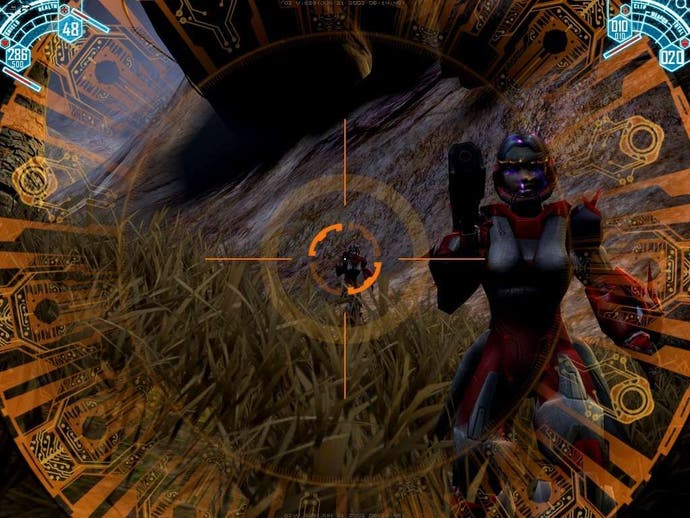
Trying its best
Unreal II really is what we love to call a flawed masterpiece. There's so much that's done well but so much which counters it to its doom - like the weapons. At about 15 in total there are simply too many, and they claw to convention like a headcrab. There's the basic pistol - totally and literally useless. I've fired it, um, twice, mostly to admire its alt-fire animation. Then there's the machine gun - straight out of Halo, except with a Flak Cannon style alt-fire. The shotgun - satisfying and crunchy, sprays at a distance and runs out of ammo fast. The grenade launcher - with loads of alternate ammunition types that will come in useful on a per-mission basis. The alien shock lance - an ASMD Core. The flamethrower - a tired but satisfying cliché, which works best on a visual level. The magnum style pistol. The this. The that. It's all so very familiar.
And how about your mission objectives? Find out why contact was lost. Find this alien artifact before [insert corporation/alien race] does. Find out what's causing the spiders to become huge and stompy. And how about the story? Find the seven sacred artefacts. Get reinstated to the Marines. Blah blah. I won't spoil it, but to be honest, you won't remember it when you get to the other end of your next FPS adventure. You'll just go "ah!" in all the right places and, if you're used to this sort of thing, soak it up with a sort of sleepy disinterest.
It's not just clichés which conspire to damage Unreal II either. There are actual problems. Invisible walls pop up now and again, as do clipping issues (particularly when a scripted ally is following you and wants to make use of a door at the same time as you), and other than the bot-style marines, enemy AI is as basic as you can get. Enemies either line up to be shot, stand around for a few seconds kindly giving you an angle before leaping up to get you (spider) or slashing you like an incensed cheetah (Skaarj) or spitting out more enemies (alien blob thing) or, or, or.
Perhaps the biggest problem though is something which you're just going to have to grin and bear. With all its sumptuous detail enabled, Unreal II sucks up a lot of processing and graphical power, and you'll need a top-end rig to really enjoy it. Our 1.8GHz Athlon XP and Radeon 9700 PRO coped as you might expect, but there was slowdown in combat and hesitation in loading scenes and so on, and we could drag it down to single figure frame rates in certain areas. Switch things off and it becomes clear that without its beautiful exterior, Unreal II doesn't boil down to a great deal. It's a very visual experience and you want to have the tech to do it justice.
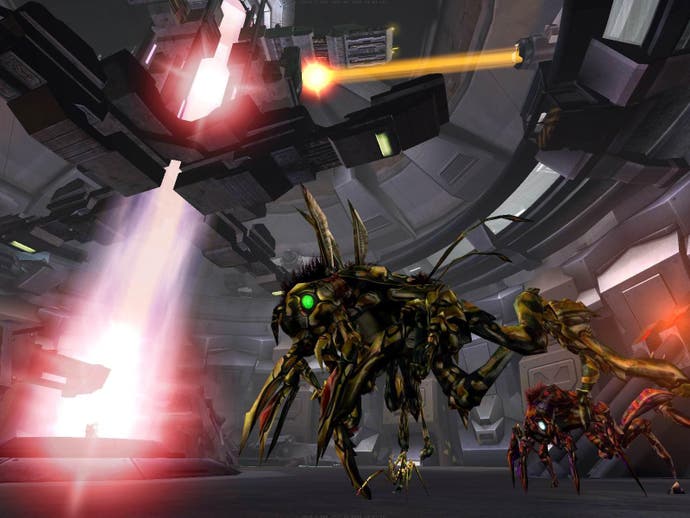
Go back to sleep…
At the end of the day, the overriding feeling when you play Unreal II is just one of ambivalence - it's the same quick save/quick load dynamic with all the same destinations, enemies, stories and screen clutter, and you know you're going to play it through to completion because it's not hard, it's no more than 10 hours' work, it's nothing you haven't done before and it looks really good. But if you plan to buy Unreal II, don't be fooled - like Halo before it it's a wonderful amalgamation of sci-fi FPS principles, but what we wanted was an exceptionally well-rounded sci-fi shooter which broke the mould. In this regard, the only mould Legend have broken is Unreal's.

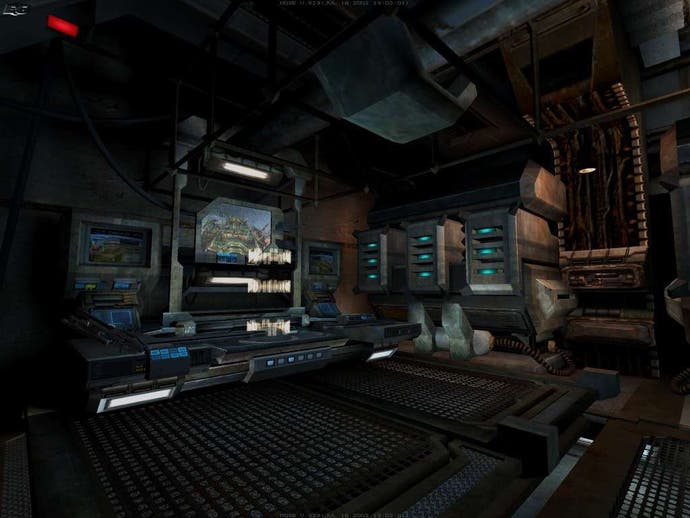
Rob's Take
It's a bone of contention between myself and many of my PC gaming associates (you know who you are), but I believe that the original Unreal was a genuine milestone in First Person Shooter gaming. The graphics were a revolutionary leap over anything that was being done by any other company at the time, the level and creature design was stunning and perhaps most importantly, the game had more atmosphere than most gas giants - with stunning scripted sequences, a magnificently conceived alien world, mysterious natives, savage invading Skaarj enemies and hauntingly wonderful music.
Okay, so the game lost its way fairly regularly, with certain aspects of it being below par. The weapons, for example, were recently described to me as being poorer than those found in the reviled Half-Life Paintball; the final levels fizzled out rather than leading to any kind of crescendo; and the constant promise of meeting up with other survivors was disappointingly not to be. However, the game was a masterpiece regardless, even if it was a flawed one.
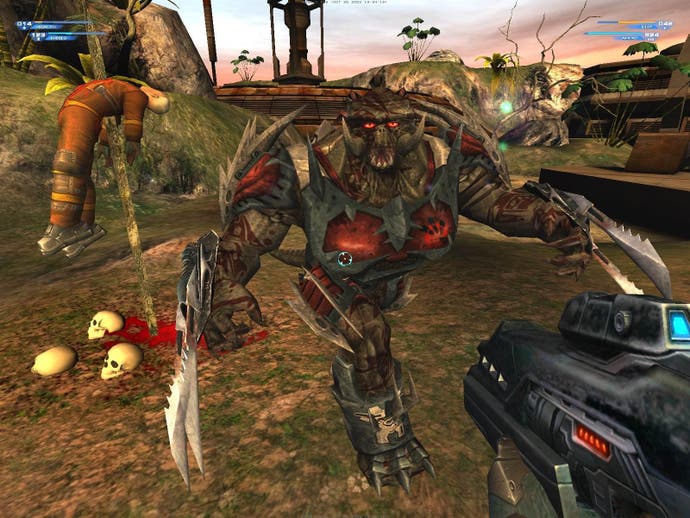
Return Ticket to Na Pali
That's why I had such high expectations of Unreal II; and that, perhaps, is why I'm ultimately so disappointed with it. The first game broke free of many of the conventions of the FPS genre at the time, whereas this sequel, for all its promise, seems only too happy to conform tightly to every cliché and stereotype it can find. We had all hoped that the solely single-player focus of the team making the game would create something rather special; sadly, this was not to be.
This isn't to say that some aspects of the game aren't rather special in themselves - most notably the graphics, which put just about every other PC game ever made to shame. Even Halo doesn't have a patch on some of the graphical trickery Unreal II has up its sleeve, and the engine is equally at home rendering claustrophobic tunnels and lush jungles. Eye candy is the order of the day; it's one of those rare games, like its predecessor, which will have you stopping every now and then just to admire the view.
Narli Healeing Plante?!
Unfortunately for fans of the first game, the team at Legend seem to have ripped up the book where everything other than the visuals of the game is concerned. Gone is the lush world of Na Pali with its mysterious natives, floating cities, homely villages and ancient temples; gone are the delicately constructed side stories and the narrative flow of the whole game. Instead, we've got a balls-out action game set on a variety of one-dimensional worlds populated by blokes in massive power-suits, big-breasted tactical officers and giant spiders, and armed with all the subtlety of a boot to the head.
Even the enemies have changed for the worse; although the sections where you fight enemy human marines and mercenaries are interesting enough in themselves, the sections featuring the Skaarj are downright poor. Whereas in Unreal, the Skaarj were sleek, fast and fearsome, in this they have been redesigned as lumbering beasts with a clumsy lunge attack - built like an, er, outside toilet, but not very scary and certainly not very clever.
Conclusions
Unreal II is a wasted opportunity. This is a game which could have taken the triumphs of the original and built something wonderful out of them; instead, it's taken little but its graphical style from the original, and has built a cliché-loving FPS title that desperately wants to be Halo but isn't quite up to standard. The graphics are very lovely indeed, and there are some nice moments, but the gameplay practically defines middle of the road. Enjoyable for an FPS junkie, certainly, but it's impossible to play it without thinking of how much more it could have been.







